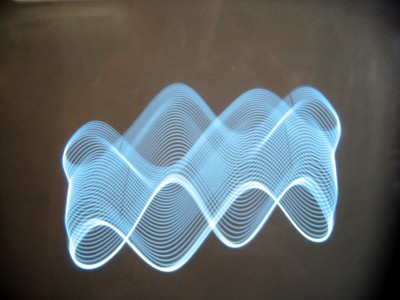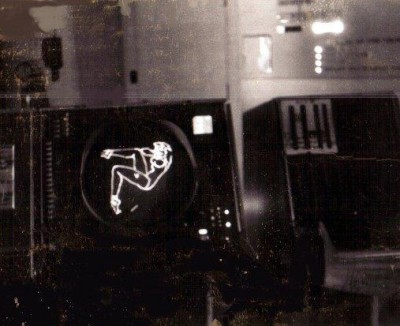The Vectorian Era
Posted in Text on November 23rd, 2016 by adminTHE VECTORIAN ERA: an Investigation into Analog Computer Graphics
The Vectorian Era opens with a screaming across the sky. Analog electronic computers predate their digital counterparts by several decades, and one of the first practical applications of the analog computer was in controlling the trajectories of German V2 rockets as they traced their rainbow of gravity from Flanders towards London during the Second World War. As Friedrich Kittler has observed, the relationship of media technology to military tools of destruction was sealed by moments such as these.
Post-war developments continued in this direction. Tennis for Two, programmed in 1958 by William Higinbotham on an analog computer at Brookhaven National Laboratories in Long Island NY USA, using an oscilloscope as the display. It combined a two-player interface with physics models of a bouncing ball displayed as vectors in motion, and is arguably the first publicly-playable video game. The laboratory itself performed government research into nuclear physics, energy technology, and national security.
In the early 1960’s, the composer Morton Subotnik employed engineer Don Buchla to help him create “the music of the future”. Buchla redesigned the existing function generators of analog computers to respond to voltage controls of their frequency and amplitude. This gave birth to the realtime-controllable, analog modular synthesizer which was subsequently expanded by others such as Bob Moog and Serge Tcherepnin.
In 1967, the Sony Portapak revolutionized video by taking the camera out of the television studio and into the hands of amateurs and artists. And by the early 1970’s, an interest in cybernetics, systems theory and automatic processes brought the analog computer closer to the worlds of art, music, and architecture. Figures such as Heinz von Foerster, Gordon Pask, Nam June Paik, Steina and Woody Vasulka, Iannis Xenakis and R. Buckminster Fuller all speculated on the effect of computers on society, and used computer-derived forms in their work. The 1972 Rutt-Etra Video Synthesizer, used famously by the Vasukas in several works, employed an analog computer to manipulate and deconstruct the raster of a conventional video signal with very otherworldly effects.
Vector graphics were widely adopted by video game manufacturers in the late 1970’s due to their computational efficiency, and the wealth of experience using them that the history of analog computing provided. Perhaps the most iconic of these games is Asteroids, a space shooter released by Atari in 1979. Battle Zone (1980), Tempest (1981), and Star Wars (1983) all stand as other notable examples from this Vectorian Era, and also as rudimentary training tools for the future e-warriors who would remotely guide missiles into Iraqi bunkers at the start of the next decade. As electronics became cheaper, smaller, and faster in the 1980’s, the dated technology of using analog vectors to directly manipulate a Cathode Ray Tube fell out of favor and rasterized graphics, animations and moving image quickly took their place.
Informed by the discourse of media archaeology, my own personal interest in analog vector graphics isn’t merely retro-for-retro’s-sake. Rather, it is an exploration of a once-current and now discarded technology linked with specific utopias and dystopias from another time. The fact that many aspects of our current utopian aspirations (and dystopian anxieties!) remain largely unchanged since the dawn of the Vectorian Era indicates to me that seeking to satisfy them with technology alone is quite problematic. Therefore, an investigation into “tried-and-failed” methods from the past casts our current attempts and struggles in a new kind of light.
Derek Holzer
23 NOV 2016
Helsinki FI
IMAGES:
–TOP: Derek Holzer, “VECTOR SYNTHESIS” study, August 2015, Berlin DE
–MIDDLE: “VECTOR SYNTHESIS” studies, January 2017, Helsinki FI
–BOTTOM: Early computer art created by anonymous IBM engineers, this pinup girl program is running on a SAGE (Semi-Automatic Ground Environment) defense computer. Polaroid photo by Lawrence A. Tipton, 1959, Ft. Lee Virginia USA. Via The Atlantic.


